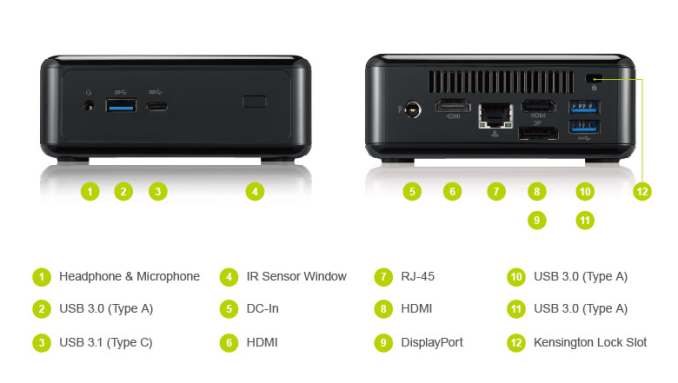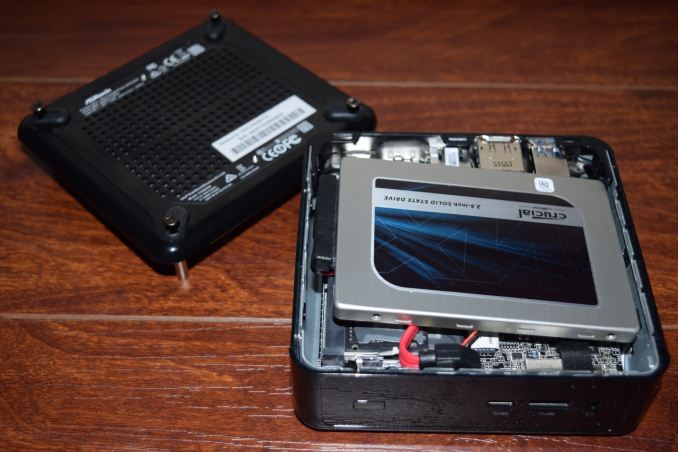ASRock Beebox-S 7200U Kaby Lake UCFF PC Review
by Ganesh T S on February 7, 2017 8:00 AM ESTFinal Words
The benefits delivered by Kaby Lake over Skylake are passable from a performance perspective. That said, the Kaby Lake media engine in the Intel HD Graphics 6xx has moved from lagging behind NVIDIA's VPU to becoming the leader in the space. In addition to HEVC Main as well as Main10 decode support, Intel is also delivering 10-bit VP9 decode. The benefits of the latter are debatable, but, on paper, the Kaby Lake GPU delivers the goods for HTPC users. The MSI Cubi 2 disappointed us a bit on this front by not opting to enable a HDCP 2.2-capable HDMI 2.0 output. This requires a LSPCon (approximately a $2 addition to the BOM according to our industry sources), and ASRock's Beebox-S 7200U integrates one. Kaby Lake's additional DRM capabilities also enable Netflix 4K streaming. All in all, the Beebox-S 7200U is an effective HTPC for casual 4K media consumers - either OTT, or, from local sources.
ASRock also manages to score on some other differentiation aspects - the availability of a USB 3.1 Gen 2 Type-C port, thanks to the ASMedia ASM1142 bridge controller, as well as a compact footprint while retaining support for a 2.5" drive. Unlike some of the other UCFF PCs in the market that opt for Realtek NICs, the Beebox-S 7200U does sport an Intel Gigabit LAN controller.
Positives aside, ASRock still has some scope for improving the Beebox-S. Most of our feedback from the Beebox-S 6200U review are still valid since the chassis design and motherboard components of the Beebox-S 7200U are almost the same (except for the processor and the BIOS).
The internal layout of the unit is very cramped, making even SODIMM installation a bit of a challenge. Installing a 2.5" drive is even more of a pain with the necessity to route the SATA cable and power wires around the SODIMM. While the initial setup issue is a one-time hassle, the effect of the SODIMM heating up on the SATA cable is a bit of a worry. ASRock must shift to a single flexible data/power cable (similar to the one used in the DeskMini 110) to address this issue. Another candidate for addressing is the decision to go with a 1x1 802.11ac WLAN card instead of the 2x2 configuration used by the Intel NUCs.
SATA Wiring Concerns with 2.5" Drives in the Beebox-S 7200U
It is best to use a M.2 2260 SSD in the unit, but, 2280 SSDs are more common. Installing such a SSD is possible, but, requires a separate plastic tab. The M.2 SSD also has no thermal protection support from the chassis design. We also found that the QVL (qualified vendors list) doesn't include many popular NVMe SSDs such as the Toshiba OCZ RD400. Usually, SSDs that are not in the QVL work without problems, but, we found that the Beebox-S 7200U just wouldn't recognize the RD400 in the M.2 slot. To top this, there is definitely some issue with the latest BIOS and the tested Samsung SSD 950 PRO NVMe SSD - the core clocks idle at the maximum rate and the Prime95 torture test occasionally results in thermal runaway and system freezing. Neither of these issues were observed with a 2.5" SATA SSD. Our suggestion to readers contemplating the purchase of a Beebox-S 7300U is to go with a 2.5" SATA SSD instead of a NVMe SSD.
The thermal solution for the processor turns out barely OK - traditional system stability tests keep the temperatures well below Tjmax. However, workloads like Prime95 make the processor enter dangerous territory and the thermal solution can't sustain the 20W package power that the system is configured for. ASRock would do well to make the thermal solution better for the next generation version.
The Beebox-S 7200U is currently available on both Amazon and Newegg for around $350 (though the Amazon first-party listing was backordered when we last checked). The corresponding MSI Cubi 2 and GIGABYTE BRIX models are currently listed at $375 and $391 respectively. Despite the shortcomings that were identified during the course of our review, the Beebox-S provides the best value for money amongst the Kaby Lake UCFF PCs currently in the market.












33 Comments
View All Comments
fanofanand - Thursday, February 9, 2017 - link
This is probably why they are tapping AMD for iGPU's, or at least those are the rumors.surfnaround - Tuesday, February 21, 2017 - link
The GTX630 (or 730, or whatever nvidia deems should fill its place) is your friend...25watt max, faster than OBG... and only tends to add 3watts at idle...
Sene - Wednesday, February 8, 2017 - link
thanks but I want to use only for 1080p, no 4K files. Would that be OK with basic settings ?HideOut - Tuesday, February 7, 2017 - link
When they gonna learn to use 2x2 AC wireless...Samus - Wednesday, February 8, 2017 - link
I know...but money. It's an easy corner to cut, annoyingly. I can't tell you how many OEM systems I upgrade monthly from crap non-AC or crap 1x1 mPCIe adapters. And it's not the simplest part to upgrade, either, when you are dealing with Dell, HP and Lenovo's obsession with whitelisting specific parts.fanofanand - Wednesday, February 8, 2017 - link
You are undoubtedly right but it's still a big impact on the user experience waiting for videos to buffer. Seems like another stupid beancounter idea.lordmocha - Wednesday, February 8, 2017 - link
"After some back and forth with ASRock, and getting hold of an updated LSPCon firmware and BIOS (v1.60), we were able to get Netflix 4K streams to work."Any word on the availability of the updated LSPcon firmware? Is it available for download, are new units being shipped with it yet?...
ganeshts - Thursday, February 9, 2017 - link
Latest LSPCon firmware with HDCP 2.2 support is already available for download in the Utilities section here:http://www.asrock.com/nettop/Intel/Beebox-S%20Seri...
I will check with them on the BIOS...
Ranger1065 - Friday, February 10, 2017 - link
It's abundantly clear that Anandtech no longer gives a damn about what its readers are interested in.BrokenCrayons - Friday, February 10, 2017 - link
AT's articles are broadly representative of what the computer industry is doing. Presuming you're interest is in DIY desktop computers, there are exactly two GPU companies and two CPU companies that release new products at predictable intervals with predictable increases in performance. Honestly, there's not much to talk about that would keep those sorts of people happy between release cycles. It'd therefore be more accurate to say that the computer industry no longer cares what Ranger1065 is interested in.